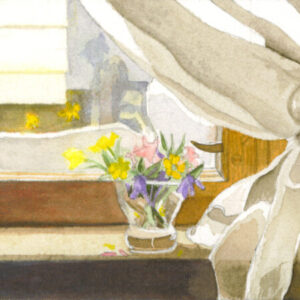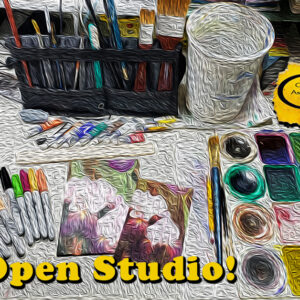Description
In this fun, low-pressure, one-time class, you will learn how to create depth and realism in your watercolor paintings with dark values. You will learn the basic skills and the principles of color theory, and apply them in order to create a variety of contrast and shadow effects without using black. The course is designed to teach absolute beginners how to draw and paint with enough confidence to continue on their own, but offers instruction and techniques that students who have already experimented with watercolor may find enlightening and instructive, and may not have learned in another beginner watercolor class.
This is both an in-person course and an online course. I will be teaching students in-person in a classroom while also teaching students online via Zoom. It will take two two-hour sessions to complete this painting. I will record the course while I’m teaching and post the video afterward for everyone who took the course (both online and in-person), so you can reference it later. It may take me a few days to a week to get the video posted.
This course comes with limited email support. After you complete the course you can email me with questions and I can give you email critiques if you send me photographs of your work.
Current Course Date: Tuesday, June 18th & Thursday, June 20th, 2024, 6:00pm to 8:00pm MST (Denver time)
IMPORTANT: This course is being taught from Montana, and we are in the MOUNTAIN time zone. If you are taking the course online, please make sure you adjust accordingly if you are in a different time zone.
If you pay for this course, and then find you have a scheduling conflict and cannot attend on that date, you may apply your ticket to a future course. However, we will use a different painting template on each of those dates. The course structure will remain the same.
Text: There is no textbook for this course. I will teach you using my own extensive experience and expertise spanning more than three decades. However, there are several texts that I will recommend in the course for students who would like to continue to develop their skills, but no books are required for this course.
Technology: If you are taking this course online, you will need a computer that meets the Zoom app requirements. You will need a working webcam, microphone, and speakers (whether built-in or separate). What You Will Learn: In this course you will:
- Demonstrate mastery of basic color theory by mixing colors that accurately match the colors represented in the photograph you are painting from using the basic principles of color theory and the color wheel, and rendering the drawing with those colors so as to match the photograph.
- Demonstrate mastery of painting technique by mixing colors that accurately match the colors represented in the photograph using the basic principles of color theory and the color wheel, and rendering the drawing with those colors so as to match the photograph.
- Demonstrate mastery of craftsmanship by exercising care and precision in the execution of your watercolor paintings, such that your paintings represent your desired outcomes as set forth at the beginning of the class; and the painting looks very similar to the photograph.
The Supplies You Will Need: If you are taking this class in person in my studio, ALL SUPPLIES WILL BE PROVIDED! You don’t need to buy or bring anything.
If you are taking the course online, I will give you a list of my favorite supplies, and what I consider to be the best or at least minimally passable for this course. However, if you already have comparable supplies, or if you do not have access to the items on my list but have reasonable substitutions available in your area, that will suffice. If you are not sure, contact me at artmaker@ceilon.com and I can help you decide if what you have will work for the course. This class is designed for beginners and intermediate learners, so there is no need for top of the line, expensive supplies. However, you will not want to use low-quality, student-grade supplies either. You will get the best results if you use the following:
- Highly absorbent paper towels
- A roll of toilet paper
- Large watercolor palette
- Two 9″x12″ pieces of Arches 140 pound cold press watercolor paper (we will only do one painting; the second piece of paper is for testing colors and trying different techniques).
- Wooden board or Masonite for painting (at least 15″x18″, so it is bigger than your paper)
- Masking tape
- Large water containers (at least a quart but preferably a gallon; Ceilon uses a gallon milk jug that has had the front top section cut out of it)
- 3 round watercolor brushes (small, medium, and large). Squirrel hair is OK, Kolinsky Sable is the best (but expensive. These are preferable to synthetic brushes, but there are some brands of synthetic brushes designed for watercolor that work fairly well.
- One 1″ flat wash brush (same type of bristles as indicated above)
- Fresh masking fluid, and brushes that you will NOT be using for watercolor (masking fluid can ruin your brushes–you should use brushes that are dedicated to your masking fluid; I sometimes use toothpicks for fine lines)
- Watercolor paints. Ceilon will be using the Winsor & Newton Cotman 12-color watercolor set. The Cotman line of Winsor & Newton watercolor paints is not as high a grade as the Winsor & Newton Professional but is better than lower quality student grade paints. I like to use a medium grade paint when teaching beginning classes so my students can see that you can get great results without spending a fortune in paints. If you continue on to advanced level classes, we use higher quality paints in those classes. Feel free to use whichever paints you like, but keep in mind that bargain paint will likely be grainy and the colors will not be as vibrant. If you do not get the set I have linked to, be sure to have the colors listed in that set, as I will be telling you how to mix colors based on what’s in that set. Just make sure the names are the same, regardless of the brand.
- A pencil
- An eraser
- A pencil sharpener (handheld or electric–it doesn’t matter; you can use a kitchen knife or razor blade to sharpen your pencils if that’s all you have)
You may also want to have some of these items on hand:
- salt
- plastic wrap
- aluminum foil
- wax crayons or candles
- facial tissue
- rubbing alcohol
- bubble wrap
You do not need to have them all. In fact, you don’t need to have any of them, but you can create some pretty cool watercolor effects if you do.





Reviews
There are no reviews yet.